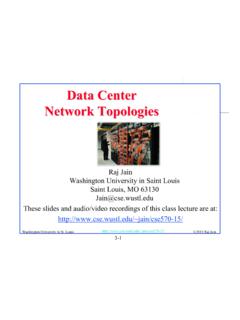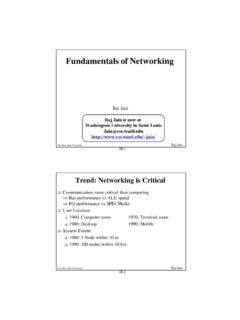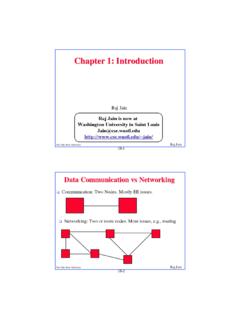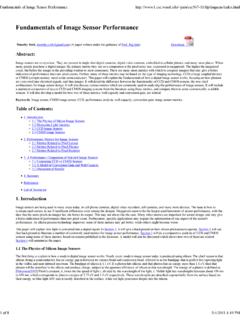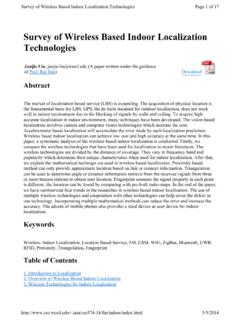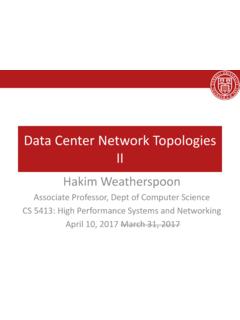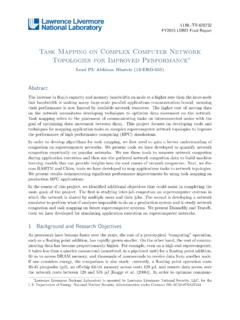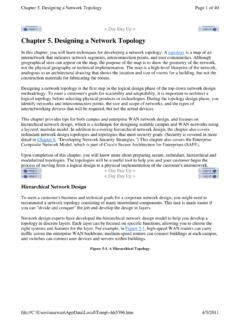Transcription of A Survey of Computer Network Topology and Analysis …
1 A Survey of Computer Network Topology andAnalysis ExamplesBrett Meador, (A project report written underthe guidance of Prof. Raj Jain)DownloadAbstractThis paper presents an introduction to Computer Network Topology . Definitions of Physical and LogicalTopologies are provided. Additionally common Computer Network realizations of Physical topologies arereviewed. This is followed by a discussion of Graph Theory and its relation to topological Analysis . Adiscussion of Analysis examples follows with an emphasis on message routing issues, Network sizing, and virusanalysis. These examples are discussed to underscore the impotance of topological design when constructinga new Computer Network , or adding to an existing :Physical Network Topology , Logical Network Topology , Minimum Spanning Tree, Graph Theory, BusNetwork Topology , Ring Network Topology , Star Network Topology , Tree Network Topology , MeshNetwork Topology , Hybrid Topology .
2 Directed Graph, Undirected Graph, Queueing Theory, CombinatorialTrials, Tree-Bus TopologyTable of Contents1. Introduction2. Physical Network Bus Network Ring Network Star Network Tree Network Mesh Network Topology3. Graph Theory4. Network Analysis Routing Network Network Corruption5. Conclusion6. Acronyms7. References1. IntroductionA Survey of Computer Network Topology and Analysis Examples1 of 11 The mathematical subject of Topology investigates objects whose characteristics are constant throughdistortion. Objects can be topologically equivalent while appearing physically different. As an example, anytwo objects formed with a simple rubber band are topologically equivalent so long as the band is not parted. Anoteworthy practical Analysis technique based on Topology is Kirchoff circuit Analysis . Computer NetworkTopology is an extension of basic Topology .
3 This discipline examines the configuration of Computer systemelements and their associated interconnections. Physical Network Topology emphasizes the hardwareassociated with the system including workstations, remote terminals, servers, and the associated wiringbetween assets. Logical Network Topology (also known as Signal Topology ) emphasizes the representation ofdata flow between nodes, not dissimilar from Graph Theory Analysis . The logical topography of a Network canbe dynamically reconfigured when select Network equipment, such as routers, is available. An examplecomparing Physical and Logical topologies is provided in Figure 1 Operations Research (OR) performance Analysis topics associated with Computer Network Topology tend tobe concerned with logical Topology instead of the purely physical. This paper will review several performanceanalysis study examples with the intent of demonstrating the importance of topological considerations innetwork design.
4 Although the problem set in this Survey is limited several of the Analysis techniques discussedare applicable to other Network Analysis problems. Since Logical Network Topology builds upon theunderlying Network Physical Topology the set of standard Computer physical topologies will reviewed first asbackground to the performance Analysis discussion. This will be followed by a brief description of GraphTheory, and then the Network Analysis Physical Network TopologiesA review of common Physical Network topologies provides a basis for the Analysis discussion presented insection 4. In this section the attributes and problems associated with Bus, Ring, Star, Tree and Mesh NetworkTopologies are Bus Network TopologyIn Bus Network Topology a single cable is used to connect all devices on the net. This cable is often referredto as the Network Backbone.
5 When communication occurs between nodes the device sending the messagebroadcasts to all nodes on the Network , but only the desired recipient digests the message. Advantages of thisA Survey of Computer Network Topology and Analysis Examples2 of 11type of Physical Topology include ease of installation and minimization of the required cabling. Further,failure of a node attached to the Network has no effect on other nodes attached to the Network . Also messagesfrom one node can be seen near simultaneously by all other nodes on the Network . Disadvantages of thisconfiguration include performance limits on the number of Network nodes, and complete networkcommunication stoppage if the cable fails. Figure 2 shows an example of Bus Network Ring Network TopologyRing Network Topology has each node in a Network connected to two other nodes in the Network inconjunction with the first and last nodes being connected.
6 Messages from one node to another then travelfrom originator to destination via the set of intermediate nodes. The intermediate nodes serve as activerepeaters for messages intended for other nodes. Some forms of Ring Network Topology have messagestraveling in a common direction about the ring (either clockwise or counterclockwise) while other forms ofthis type of configuration (called Bi-directional Rings) have messages flowing in either direction with the helpof two cables between each connected node. In some cases blocking devices are required in a Ring TopologyNetwork in order to prevent packet storming, the condition where packets not consumed by a Network nodefall into an unlimited loop about the ring. Ring Network Topology is typically employed in networks whereinter node traffic volume is small. A disadvantage of the basic Ring Network Topology is the relatively longtransmission time between nodes in the ring as compared with Bus Network Topology .
7 Further, like BusNetwork Topology , failure of the cabling between any two nodes has a broader impact on networkcommunication as a whole, possibly leaving no path from message originator to recipient. Relative inter nodecommunication delays are still a disadvantage of the Bi-directional Ring Network , however the dual nature ofthe cabling between nodes allows traffic to be shunted to an alternate path, thereby rectifying connectiondisruption between any two nodes in the Network . This is a considerable reliability advantage over the basicRing Network Topology or the Bus Network Topology . Ring Network topologies do have uniquedisadvantages relative to other topologies concerning expansion or reconfiguration. If a node is added newcabling is required to connect the node to its two neighbors. Networks are not often constructed withpre-wired positions to account for expansion.
8 Figure 3 shows examples of Ring Network Survey of Computer Network Topology and Analysis Examples3 of Star Network TopologyStar Network Topology requires the use of a central top level node to which all other nodes are top level node may be a Computer , or a simple switch, or just a common connection point. Messagesreceived by the top level node can either be broadcast to all subordinate nodes, or if the top level device is ofhigh enough fidelity, sent only to the desired subordinate node. Inter node messaging delays are reduced withthis configuration. An important advantage of the Star Network Topology comes from the localization ofcabling failures inherent in this configuration. Failure in the connection between the top level node and anysubordinate node, or failure in a subordinate node will not disrupt the entire Network . Because Star NetworkTopologies are commonly used in LANs spanning a larger geometric area than Bus or Ring NetworkTopologies.
9 One disadvantage of this configuration is the need for more cabling. Another disadvantages lieswith the top level node. Any failure in this device will halt any communication on the Network . One additionallimitation of the Star Network Topology concerns the limited number of top level node connection 4 shows an example of Star Network Tree Network TopologyA Survey of Computer Network Topology and Analysis Examples4 of 11 Tree Network Topology is constructed from either making a set of Star Network topologies subordinate to acentral node, or by linking a set of Star Network topologies together directly via a bus, thereby distributingthe functionality of the central node among several Star Network Topology top level nodes . Figure 5 providesan example of each configuration. The top level nodes from each Star Network are the elements linked via abus in the second arrangement.
10 In simple Tree Network Topology no Star Network Topology subordinatenodes are connected to the bus. Messages in a Tree Network Topology can be either broadcast from thecentral node to all interconnected Star Networks, or targeted to select Star Networks. One major advantage ofthe Tree Network Topology is the ease at which the Network can be expanded. Expansion can be as simple aslinking in an additional Star Network Topology onto the bus. Also, like the Star Network Topology there islocalization of cabling failures with this configuration. However, if a Star Network top level node in the fails,or cabling to it fails an entire section of the Network is lost to communication as opposed to just onesubordinate node as in pure Star Network Mesh Network TopologyMesh Network topologies capitalize on path redundancy. This Topology is preferred when traffic volumebetween nodes is large.
